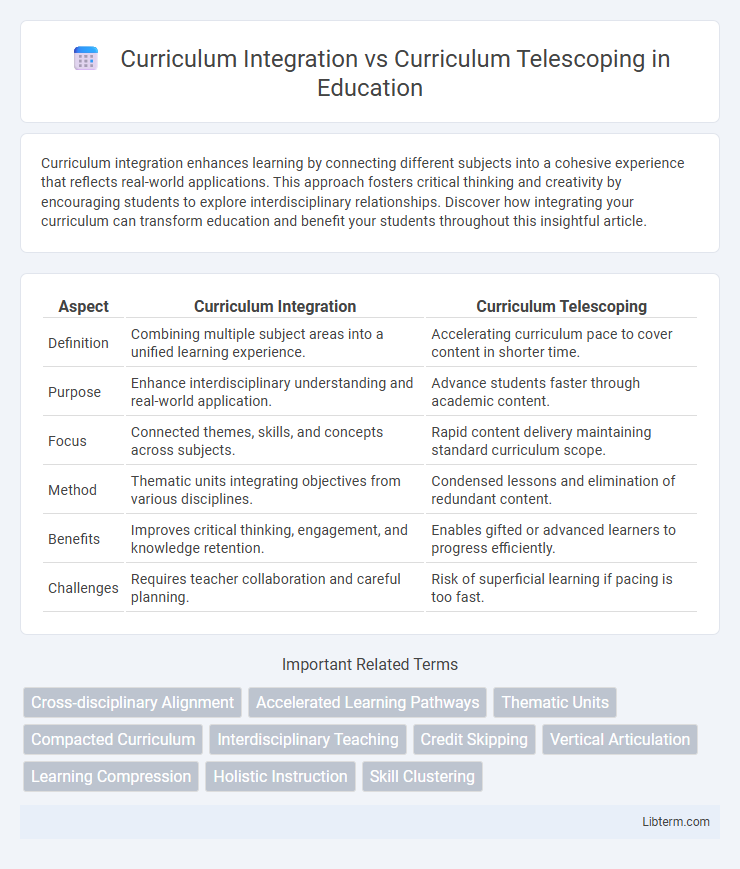Curriculum integration enhances learning by connecting different subjects into a cohesive experience that reflects real-world applications. This approach fosters critical thinking and creativity by encouraging students to explore interdisciplinary relationships. Discover how integrating your curriculum can transform education and benefit your students throughout this insightful article.
Table of Comparison
| Aspect | Curriculum Integration | Curriculum Telescoping |
|---|---|---|
| Definition | Combining multiple subject areas into a unified learning experience. | Accelerating curriculum pace to cover content in shorter time. |
| Purpose | Enhance interdisciplinary understanding and real-world application. | Advance students faster through academic content. |
| Focus | Connected themes, skills, and concepts across subjects. | Rapid content delivery maintaining standard curriculum scope. |
| Method | Thematic units integrating objectives from various disciplines. | Condensed lessons and elimination of redundant content. |
| Benefits | Improves critical thinking, engagement, and knowledge retention. | Enables gifted or advanced learners to progress efficiently. |
| Challenges | Requires teacher collaboration and careful planning. | Risk of superficial learning if pacing is too fast. |
Understanding Curriculum Integration
Curriculum integration involves combining multiple subject areas into a cohesive learning experience, enhancing students' ability to connect concepts across disciplines. It promotes critical thinking and real-world application by blending knowledge and skills from different fields into meaningful projects. Understanding curriculum integration is essential for designing interdisciplinary lessons that foster deeper comprehension and holistic education.
Defining Curriculum Telescoping
Curriculum telescoping refers to the educational practice of condensing a standard curriculum into a shorter time frame, enabling students to accelerate their learning pace by covering content more quickly than in traditional programs. This approach often benefits advanced learners or those aiming to graduate early, as it emphasizes mastery of essential concepts without extending overall instructional time. Unlike curriculum integration, which combines subjects to create interdisciplinary learning experiences, telescoping maintains a traditional subject structure but compresses the timeline for content delivery.
Key Differences Between Integration and Telescoping
Curriculum integration involves combining multiple subjects into a cohesive learning experience that emphasizes interconnected knowledge, while curriculum telescoping compresses content to teach it in a shorter timeframe without sacrificing essential topics. Integration fosters deeper understanding through thematic connections across disciplines, whereas telescoping prioritizes efficiency by accelerating the curriculum delivery. These approaches differ fundamentally in intent: integration seeks holistic learning synergy, and telescoping aims at time management and early mastery.
Educational Goals: Integration vs. Telescoping
Curriculum integration emphasizes the alignment and blending of subjects to achieve holistic educational goals, fostering interdisciplinary understanding and real-world application. Curriculum telescoping accelerates content delivery, compressing material timelines to meet advanced learning objectives or accommodate gifted students. Integration prioritizes depth and connection among disciplines, while telescoping focuses on pacing and compacting curriculum to optimize time efficiency in reaching educational targets.
Benefits of Curriculum Integration
Curriculum integration fosters interdisciplinary learning, allowing students to make connections between subjects and apply knowledge in real-world contexts, which enhances critical thinking and retention. It promotes collaboration among educators, aligning content and teaching methods for a cohesive learning experience that addresses diverse learning styles. This approach also supports holistic development by integrating skills and knowledge, preparing students for complex problem-solving and lifelong learning.
Advantages of Curriculum Telescoping
Curriculum telescoping accelerates students' learning by condensing the standard curriculum into a shorter time frame, allowing gifted or advanced learners to progress at a pace that matches their abilities. This approach maximizes academic efficiency and engagement by minimizing redundancy and offering early exposure to more challenging material. Enhanced motivation and retention often result from the increased rigor and personalized pace inherent in curriculum telescoping models.
Challenges in Implementing Integrated Curricula
Implementing integrated curricula faces challenges such as aligning diverse subject standards, managing teacher collaboration, and ensuring comprehensive assessment strategies. Curriculum integration requires cohesive planning to avoid content gaps, while curriculum telescoping risks overwhelming students by compressing learning timelines. Navigating these complexities demands effective professional development and institutional support to maintain educational quality and student engagement.
Obstacles in Curriculum Telescoping
Curriculum telescoping faces significant obstacles such as student cognitive overload and insufficient mastery of foundational knowledge, leading to gaps in learning progression. Teachers may struggle with limited instructional time and lack of resources to effectively compress content without compromising depth and comprehension. These challenges hinder the successful implementation of telescoped curricula, impacting overall educational outcomes.
Choosing the Right Approach for Your Learners
Selecting between curriculum integration and curriculum telescoping requires evaluating learners' developmental readiness and instructional goals. Curriculum integration fosters interconnected understanding by blending subjects, ideal for learners benefiting from holistic perspectives, while curriculum telescoping accelerates content delivery for advanced students needing compacted learning paths. Tailoring the approach to cognitive abilities and learning objectives ensures optimal engagement and mastery.
Future Trends in Curriculum Design
Future trends in curriculum design emphasize personalized learning pathways, which align more closely with curriculum integration by fostering interdisciplinary connections and real-world applications. Curriculum telescoping remains relevant for accelerating mastery in advanced learners, yet integration's holistic approach supports 21st-century skills development such as critical thinking, creativity, and collaboration. Emerging technologies and data analytics will enhance curriculum integration models, enabling adaptive learning environments tailored to diverse student needs and promoting seamless content convergence across disciplines.
Curriculum Integration Infographic

 libterm.com
libterm.com